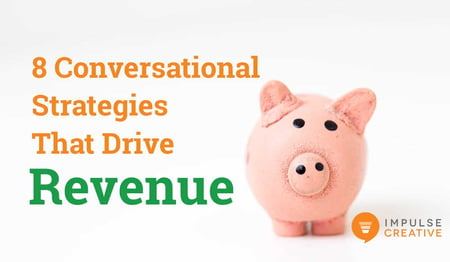Conversations. They’re all around us. We’re in multiple conversations everyday.
And then as soon as we put on our marketing, sales or service hat, we turn into that awkward kid who can’t seem to talk to anyone. And it’s sad.
Why, as businesses, do we make it weird?
If you want to drive revenue in this new world of relationship economy, you’ll want to pay attention.
In the most recent research done, 8 of every 10 consumers are willing to use messaging apps to get customer assistance. That same number of people rate an immediate response as very important when they have a marketing or sales question.
But there’s a disconnect. Only about a third of companies use live chat for marketing, sales or customer service inquiries.

If 80% of your customers want to communicate quickly and in the most comfortable way for them, why aren’t we doing it?
Can you imagine someone asking for your business phone number 10 years ago, and you tell them you only talk to people through letters in the mail?

That’s basically how we’re treating customers and prospects today.
Conversational communication - marketing, sales and service - is where you’ll need to implement strategy. Did you know that conversational marketing can double your business?
The secret behind it is this: Stop writing content that speaks to a group of people. They don’t read it in a group. Make it a start of a conversation with the person reading it.
Not sure what it means to be conversational? Let’s start there.
What it Means to be Conversational
Connection
In order to have an effective conversation, you need to create a connection. That means context and understanding. If we understand where someone is coming from, it's very easy for us to start to engage in a conversation. In person that might mean eye contact and non-verbal cues.
Online, that looks different. But we can still connect through context and empathy.
Value
When developing a conversation that moves forward, thinking about value and what each side offers may seem transactional at first. However, the fact is we’re all looking for what we can give and get out of a conversation. If we want to create a meaningful conversation, we've got to make sure that it's equal on both sides.
Trust
Another aspect of an effective conversation is trust. Trust is something that has to be given on both sides in order for a conversation to be truly effective. We build trust through empathy, connection and offering value.
1-1 > 1-Many
These things add up to real connections and conversations because one-to-one is greater than one to many. Which is how we’ve always marketed to our customers.
Broadcasting our message to as many people as possible doesn’t work as well as it used to. Now we have to be ready to have conversations with one person in order to drive revenue.
The good news? We can still scale those conversations.

8 Conversational Strategies that Drive Revenue
Ready to implement conversation into your communication plan? The best place to start is with live chat and chatbots on your website.
If you’ve paid attention to the marketing landscape over the last year or so, you’ve seen HubSpot’s flywheel. These strategies mirror that strategy for marketing, sales and service.
What is the Flywheel?

- Attract (The Subscriber, The Pillar Page Converter, The Surveyor)
- Engage (The Meeting Helper, The Demo Bot, The A-Lead Connector)
- Delight (The Supporter, The Greeter)
Conversational Strategy for Revenue 1: The Subscriber
You invest a ton of time into content. You have readers who could provide valuable feedback in addition to just their email. The Subscriber bot can ask context questions so you’re gathering information on your subscribers and better serving them.
Conversational Strategy for Revenue 2: The Pillar Page Converter
Pillar pages are great for attracting the right types of people to your website. They have multiple levels of intent and traffic that’s driven to the page. Plus pillar pages are pages that should always grow. A bot on your pillar page can help those in discovery mode actually discover more of your content and continue on their journey with you.
Conversational Strategy for Revenue 3: The Surveyor
You’re always focusing on creating content for your personas. When’s the last time you asked your personas what they need help with? This bot will allow for you to “ask and guide” to the right content. Plus you gain insights into what people are looking for, and guide them to content that already exists.
Conversational Strategy for Revenue 4: The Meeting Helper
Meeting links can feel impersonal. What if you could converse with a visitor and guide them through the process of setting up a meeting just like you would IRL?
When you’re in cold-outreach mode, you’re giving people access to your calendar without much context about who you are, or who they are. The meeting helper solves for that.
Conversational Strategy for Revenue 5: The Demo Bot
Many prospects coming to your website may be considering a demo, but don’t convert. The Demo Bot helps them see the value and talk through it without tying up a representative.
Plus while the demo page can’t follow them around to other pages, a demo bot can. It can also accelerate the intended action by teasing or providing context based on additional pages
Conversational Strategy for Revenue 6: The A-Lead Connector
Not all leads are equal. You have SQLs that are better-qualified than others. With this strategy, you can have prompts that follow these A-Leads who you know are key opportunities. Then you can reconnect when they return to your site!
Conversational Strategy for Revenue 7: The Supporter
We all know it’s easier and more cost effective to keep a customer than it is to find new ones. With The Supporter, you can connect customers to the right person instantly.
You can also connect your sacred FAQ page to the bot to solve problems rather than just ranking in search engines. Because… customer experience matters.
Conversational Strategy for Revenue 8: The Greeter
Greet customers or evangelists/ambassadors with a contextually accurate and personal message. This takes delight to a new level. Your website acts as a concierge who guides them, drops value and even offers upgrades.
Tie These Conversational Bots into Your Current Strategy
1) Look for High Intent Pages
These are pages like your service and pricing pages. Not sure which pages are high intent? Ask your sales people, “What are the website pages you’d want to know someone is looking at before you talk to them?” They’ll tell you.
2) Look for High Traffic Pages
Next, look for the most popular pages on your website. Find these in your analytics tool. They get the most eyeballs.
3) Compare High Intent and High Traffic Pages
Where do you have crossover? Find the pages with the highest traffic and they viewers are the most likely to do business with you, and you’ve got a great place to start with your conversational chatbots.
4) Build Your User Story
We use a “I am a ___ and I want to ___ so I can ___” model. This takes a buyer persona and makes it super powerful and relevant so their experience is stellar.
5) Build Your Conversation
Now that you know the user’s story, you can build a real conversation with them. Maybe they’re a CEO of a company looking to grow their business and drive more leads. Your conversation can center on things like ROI and lead generation rather than logos and branding.
6) Launch, Test, Iterate
Always be testing! Launch your first bot on a high intent, popular page, answer questions, and see the response. Make adjustments, and check the progress.
Focus on the First Question
BONUS: Conversational Tips
As you build your conversational strategy, keep these tips in mind. We’ve learned in our journey that these four tips will lead to even greater success.
Be Human
We have amazing technology at our fingertips as marketing and sales professionals. It allows us to automate a lot of tasks, which can lead to feeling quite robotic with our process.
The danger? It allows for us to forget the user on the other side as a human. Add compassion, empathy and personality to your conversations to feel more human and build a relationship.
Give and Get
Many marketers today feel the need to have the least amount of form fields on a landing page to get the highest conversion. We know that users want to give the least amount of information for the most amount of value. That can be great.
But here’s the thing: We can't just make a chatbot that feels like a form. Because then you should just have a form. Instead, with chat you can have a delicate balance of asking for that context, asking for those “whys” and then providing context and value.
Brevity Wins
Short, brief answers win. Period. You don’t want your users feeling like they’re texting someone who’s going to send them a novel.
When someone texts you an opus, do you respond with one or two words?
Picture this. You’re an agency with a client that hits your chat and says “My website’s down.”
If it takes you just five minutes to solve all of their problems and get their website back up, they should be happy. But if you don’t answer quickly and briefly, at four minutes and 59 seconds, how do they feel?
When they converse, you’ve got to be brief, you’ve got to be quick.
Greet. Investigate. Solve.
It all comes down to this. When someone hits your chat, treat it like a face-to-face conversation. Greet them. Ask relevant questions. Then solve whatever they’re looking for.
When you're on a customer service call on the phone companies are doing this. But as soon as it goes to chat, we forget how to have a conversation.
In the website down example, here’s how you can do this.
“I'm so sorry, your website's down. Let me check into that for you. It might take a minute.” Then you come back in five minutes. They're like, “Oh my goodness, you're amazing.”
Take the Next Step
Want to dive deeper into these strategies and more?





